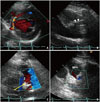A 22-year-old man was hospitalized for right femur fracture due to a motorcycle accident. Although he had no known cardiac or family history, he felt intermittent chest tightness during moderate intensity of exercise. His electrocardiography showed patterns of left ventricular strain. The echocardiography showed left ventricular hypertrophy, mild eccentric mitral regurgitation, and regional wall motion abnormality and thinning of left anterior descending (LAD) coronary artery territory with lower normal left ventricular systolic function, in which ejection fraction was 50%. Diastolic flow showing peak velocity of 2.5 cm/sec was observed at interventricular septum, which was suspicious of excessive collateral flow at parasternal short axis view (Fig. 1A). Dilated right coronary artery (RCA) ostium of 10 mm was observed (Fig. 1B) on parasternal long axis view, whereas left main coronary artery was not detected in typical situs. Notably, an abnormal retrograde shunt flow was detected (Fig. 1C, Supplementary movie 1) and a drainage site of abnormal shunt flow was observed at the main pulmonary artery (PA) level of parasternal short axis view (Fig. 1D). Thus, we suspected a congenital anomaly of the coronary arteries. Coronary angiography revealed an enlarged and tortuous RCA with abundant septal collateral flows toward the left coronary artery (LCA). An unusual location of the left main coronary artery opening with an abnormal retrograde shunt flow was observed in the left superior part of aorta, most likely PA (Fig. 2A and B, Supplementary movie 2). However, LCA was not shown in the left coronary cusp (Fig. 2C). To specify the location of the left main coronary artery opening, cardiac multidetector computed tomography (CT) was performed and the anomalous origin of left coronary artery from pulmonary artery (ALCAPA) was finally confirmed (Fig. 2D and E). To determine myocardial viability, cardiac magnetic resonance imaging (MRI) was performed and the thinning and subendocardial delayed enhancement of anterior wall from base to middle left ventricle was observed, which suggested chronic subendocardial infarction of LAD territory (Fig. 2F). The patient received beta-blocker and angiotensin converting enzyme inhibitor, and completed femur fracture surgery without any cardiovascular events. He was discharged and is scheduled for an open cardiac surgery for the correction of ALCAPA.
ALCAPA is a very rare congenital heart disease with reported incidence rate of 1 in 300000 children, or 0.5% of those with congenital heart disease.1) If untreated, up to 90% of patients with ALCAPA die during the first year of life due to severe myocardial ischemia. Only 10–15% of ALCAPA patients reach adulthood depending on the development of sufficient inter-coronary communications.2) Despite abundant collaterals, blood supply to LCA territory can be inadequate, especially to the subendocardial region according to the proportion of coronary steal from coronary artery to PA.
For a precise diagnosis and risk stratification of ALCAPA, multimodality imaging studies are needed. Echocardiography is essential and provides important clues for diagnosis of ALCAPA, as demonstrated in our case. RCA dilatation, collateral coronary artery flow, LCA flow reversal, mitral regurgitation, and left ventricular dysfunction are known as important echocardiographic findings of ALCAPA.3) Cardiac CT is useful for visualization of coronary arteries, but is limited in evaluating coronary flow, valvular function, and myocardial viability. Cardiac MRI provides more detailed information on myocardial perfusion, fibrosis, and viability for deciding treatment plan. Coronary angiography is definitive diagnostic modality for providing anatomic information of anomalous coronary arteries and their flow. There are no current guidelines for the optimal treatment of ALCAPA. According to previous literatures, surgical correction has good prognosis and is recommended regardless of age or symptoms in order to prevent adverse outcomes including myocardial infarction or sudden cardiac death.4)
We present a very rare case of an adult type ALCAPA accompanied by chronic subendocardial infarction, which was initially suspected by echocardiography and confirmed by multimodality imaging studies. The present case also emphasizes the essential role of echocardiography for providing important clues of ALCAPA.
Figures and Tables
 | Fig. 1An accelerated diastolic color flow within the interventricular septum indicating a large septal collateral flow with frontal direction from RCA to left anterior descending artery on parasternal short axis view (A). Markedly dilated RCA ostium on parasternal long axis view (arrowheads) (B). Retrograde diastolic shunt flow toward pulmonary valve at MPA (arrow) (C). Drainage site of abnormal shunt flow at MPA with diastolic reversal flow (D). MPA: main pulmonary artery, RCA: right coronary artery. |
 | Fig. 2Coronary angiography showing an enlarged and tortuous RCA from Ao (A). Retrograde filling of LCA through abundant collaterals from RCA and abnormal shunt flow from left main stem to main PA (B). No visualization of LCA in left coronary cusp (C). Sagittal section and 3D reconstruction images of computed tomography of the LCA originating from the PA with retrograde contrast flow from LCA to PA (D and E). Thinning and subendocardial delayed enhancement of anterior LV wall on cardiac magnetic resonance imaging (F). Ao: aorta, LM: left main artery, LCA: left coronary artery, LV: left ventricle, MPA: main pulmonary artery, PA: pulmonary artery, RCA: right coronary artery. |
References
1. KEITH JD. The anomalous origin of the left coronary artery from the pulmonary artery. Br Heart J. 1959; 21:149–161.
2. Moodie DS, Fyfe D, Gill CC, Cook SA, Lytle BW, Taylor PC, Fitzgerald R, Sheldon WC. Anomalous origin of the left coronary artery from the pulmonary artery (Bland-White-Garland syndrome) in adult patients: long-term follow-up after surgery. Am Heart J. 1983; 106:381–388.
3. Patel SG, Frommelt MA, Frommelt PC, Kutty S, Cramer JW. Echocardiographic diagnosis, surgical treatment, and outcomes of anomalous left coronary artery from the pulmonary artery. J Am Soc Echocardiogr. 2017; 30:896–903.
4. Kottayil BP, Jayakumar K, Dharan BS, Pillai VV, Ajitkumar V, Menon S, Sanjay G. Anomalous origin of left coronary artery from pulmonary artery in older children and adults: direct aortic implantation. Ann Thorac Surg. 2011; 91:549–553.




 PDF
PDF ePub
ePub Citation
Citation Print
Print


 XML Download
XML Download